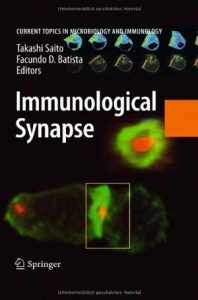نام کتاب: Immunological Synapse
نویسنده: Michael L. Dustin و Takashi Saito و Facundo D. Batista
ویرایش: ۱
سال انتشار: ۲۰۱۰
کد ISBN کتاب: ۳۶۴۲۰۳۸۵۷۳, ۹۷۸۳۶۴۲۰۳۸۵۷۰,
فرمت: PDF
تعداد صفحه: ۲۵۵
حجم کتاب: ۳ مگابایت
کیفیت کتاب: OCR
انتشارات: Springer-Verlag Berlin Heidelberg
Description About Book Immunological Synapse From Amazon
The proper physiological functioning of most eukaryotic cells requires their assembly into multi-cellular tissues that form organized organ systems. Cells of the immune system develop in bone marrow and lymphoid organs, but as the cells mature they leave these organs and circulate as single cells. Antigen receptors (TCRs) of T cells search for membrane MHC proteins that are bound to peptides derived from infectious pathogens or cellular transformations. The detection of such speci?c peptide–MHC antigens initiates T cell activation, adhesion, and immune-effectors functions. Studies of normal and transformed T cell lines and of T cells from transgenic mice led to comprehensive understanding of the mole- lar basis of antigen-receptor recognition and signaling. In spite of these remarkable genetic and biochemical advances, other key physiological mechanisms that par- cipate in sensing and decoding the immune context to induce the appropriate cellular immune responses remain unresolved. TCR recognition is tightly regulated to trigger sensitive but balanced T cell responses that result in the effective elimination of the pathogens while minimizing collateral damage to the host. The sensitivity of TCR recognition has to be properly tempered to prevent unintended activation by self-peptide–MHC complexes that cause autoimmune diseases. It is likely that once the TCR is engaged by a peptide– MHC and TCR signaling begins, additional regulatory mechanisms, involving other receptors, would increase the ?delity of the response.
درباره کتاب Immunological Synapse ترجمه شده از گوگل
عملکرد فیزیولوژیکی مناسب اکثر سلولهای یوکاریوتی نیاز به مونتاژ آنها در بافتهای چند سلولی دارد که سیستمهای اندام سازمان یافته ای را تشکیل می دهند. سلول های سیستم ایمنی در مغز استخوان و اندام های لنفاوی ایجاد می شوند ، اما سلول ها با بالغ شدن این اندام ها را ترک می کنند و به صورت تک سلولها گردش می کنند. گیرنده های آنتی ژن (TCR) سلول های T پروتئین های MHC غشایی را جستجو می کنند که به پپتیدهای حاصل از پاتوژن های عفونی یا تحولات سلولی متصل می شوند. تشخیص چنین آنتی ژنهای پپتیدی – MHC ویژه ، فعال سازی سلولهای T ، چسبندگی و عملکردهای ایمنی را آغاز می کند. مطالعات مربوط به رده های سلولی T طبیعی و تبدیل شده و سلولهای T از موشهای تراریخته منجر به درک جامع و اساسی مولکول شناسایی و سیگنالینگ گیرنده های آنتی ژن شد. علی رغم این پیشرفتهای چشمگیر ژنتیکی و بیوشیمیایی ، سایر مکانیزمهای کلیدی فیزیولوژیکی که در سنجش و رمزگشایی زمینه ایمنی برای القای پاسخهای ایمنی سلولی مناسب مشارکت دارند ، حل نشده باقی مانده اند. تشخیص TCR دقیقاً تنظیم می شود تا پاسخهای سلول T حساس ، اما متعادل را ایجاد کند که منجر به از بین بردن موثر عوامل بیماریزا می شود در حالی که آسیب جانبی به میزبان کاهش می یابد. حساسیت تشخیص TCR باید به درستی تعدیل شود تا از فعال شدن ناخواسته توسط مجتمع های خودپپتیدی – MHC که باعث بیماری های خود ایمنی می شوند ، جلوگیری کند. این احتمال وجود دارد که هنگامی که TCR توسط یک پپتید – سیگنالینگ MHC و TCR شروع می شود ، مکانیسم های نظارتی اضافی ، با گیرنده های دیگر ، باعث افزایش ظرافت پاسخ می شود.
[box type=”info”]![]() جهت دسترسی به توضیحات این کتاب در Amazon اینجا کلیک کنید.
جهت دسترسی به توضیحات این کتاب در Amazon اینجا کلیک کنید.![]() در صورت خراب بودن لینک کتاب، در قسمت نظرات همین مطلب گزارش دهید.
در صورت خراب بودن لینک کتاب، در قسمت نظرات همین مطلب گزارش دهید.

